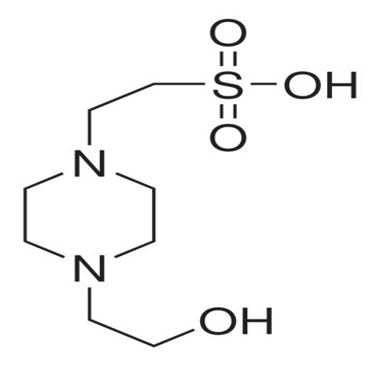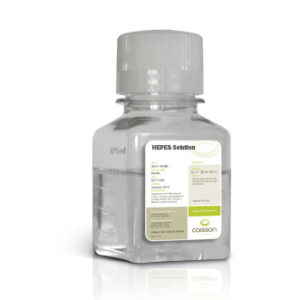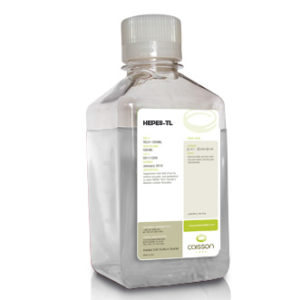Additional information
Brand
Caisson Labs
Product Storage Conditions
15 to 30°C
Product Shipping Conditions
Ambient
Product Attributes
| Weight | N/A |
|---|---|
| Dimensions | N/A |
| Format | |
| Size |
Synonyms: N-(2-Hydroxyethy)piperazine-N’-(2-Ethanesulfonic acid); 4-(2-Hydroxyethyl)piperazine-1-ethanesulfonic acid
CAS# 7365-45-9
Molecular Weight: 238.3
Molecular Formula: C8H18N2O4S
$142.21 – $568.16
Caisson Labs
15 to 30°C
Ambient
| Weight | N/A |
|---|---|
| Dimensions | N/A |
| Format | |
| Size |
A chemically stable piperazinic buffering agent that is used as the best buffer in cell culture media and cryopreservation media. It is utilized in biological researches related to the fields of biochemistry and molecular biology [1].
Introduction
Structure

Figure 1: Structure of HEPES [1]
Procedure
The procedure of making 4-(2-hydroxyethyl)-1-piperazine ethane sulfonic acid (HEPES buffer) in the laboratory is discussed below in detail [9] [10].
Applications
The practical applications of HEPES buffer (C8H18N2O4S) in various fields are eloquently described.
Specifications
Following are the specifications of 4-(2-hydroxyethyl)-1-piperazine ethane sulfonic acid that are discussed below in the table [1][2][3][4].
| Properties | HEPES Buffer |
|---|---|
| State | Present in both solid or liquid form |
| Appearance |
|
| Color |
|
| Odor | Odorless |
| Molecular Formula | C8H18N2O4S |
| Nature | Hygroscopic |
| Molecular Weight | 238.3 |
| Solubility | Soluble in water |
| Stability | Enzymatically and chemically stable |
| pKa at 25°C | 7.45 – 7.65 |
| Solubility in H2O | 70.36g/100ml |
| Storage Temperature | Stored at room temperature |
| Heavy Metals | Less than or equals to 5 parts per million |
| Moisture | Less than or equals to 0.5% |
| Melting Point | 234 degrees Celsius |
| Formal Charge | 0 |
| Saturation | 2.25M |
| Packaging | Poly bottles |
| Assay | Less than or equals to 99.5 |
| European Community Number | 230-907-9 |
| CAS Number | 7365-45-9 |
| PubChem ID | 23831 |
| InChI | 1S/C8H18N2O4S/c11-7-5-9-1-3-10(4-2-9)6-8-15(12,13)14/h11H,1-8H2,(H,12,13,14) |
| InChI Key | JKMHFZQWWAIEOD-UHFFFAOYSA-N |
| SMILES | C1CN(CCN1CCO)CCS(=O)(=O)O |
References
Hazard and safety measures of HEPES buffer are described below [12].
References
| Product Lot Number: |

Molecular Formula:C8H18N2O4S – 1 Molar (238.3 g/L).

Supplement with BSA (Fract V), sodium pyruvate, and gentamicin to make HEPES-TALP (Tyrode’s Albumin Lactate Pyruvate).

Format: Liquid, Size: 500 ML